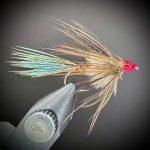Ditch Chicken

Nymph
Tied By Joe Glessner
Hook: Any 2xl Nymph hook, Size #2-12 (Eupheng #10 as tied)
Thread: 6/0 Semperfli CWT, Red
Body Parts: tail, rib, abdomen, prop, hackle
Materials: Cock Ringneck Pheasant Rump Feather, Blue/Green, Copper Wire, Brassie size, Ringneck Pheasant Tail, 6 fibers as tied, Ringneck Pheasant Aftershaft Feather, Cock Ringneck Pheasant Flank Feather
Notes:
Tying Instructions:
- Secure the hook in the vise and attach the thread using a jam wrap, establishing an index point one eye length behind the hook eye.
- Using touching turns, wrap back to the bend of the hook.
- Take three wraps directly over top of each other at the hook bend, and end by advancing the thread one wrap. This creates a prop for the tail.
- Select a rump feather with fibers that are as close to the length of the hook shank as possible. You want the bluest feather you can find of the correct length. Strip the fluff from the bottom of the feather to make the next step easier.
- Fold the barbs and bunch them. The tail should be just a hair longer than the hook shank. Mount the tail to the top of the hook shank, wrapping only forward using touching turns, cover the tail feather waste to about the 2/3 point on the hook shank, then trim away the excess.
- Mount the wire rib on the bottom of the hook shank, and take touching turns back to just in front of the tail, taking care to keep the wire on the bottom of the hook shank.
- Select an appropriate number of pheasant tail barbs, straightening the tips before removing them from the feather. Trim the tips to make them flush. Tie the barbs in on the near side of the hook by the tips, with the butts extending toward the tail. Advance the thread to the 2/3 point on the shank, covering the tips neatly along the way.
- Keeping the fibers as flat as possible, counter wrap the pheasant tail forward to the 2/3 point and secure it with the thread before trimming away the excess.
- Using open spirals, wrap the wire rib forward to the 2/3 point before securing it and helicoptering the excess free.
- Select a flank feather. You’re looking for an iridescent blue feather, usually found low on the flank, with barbs that are slightly longer than the hook. You can see the area of the flank where these are found in one of the additional images here. Pluck the feather you choose being careful to also get the aftershaft feather with it (almost every feather on these birds have an aftershaft feather; a smaller fluffy, delicate, and usually gray feather behind the base of the visible plumage).
- Separate the aftershaft feather and strip a few fibers from the bottom of its rachis to create a tie in point. Mount the aftershaft feather at the 2/3 point on the hook shank, and palmer it forward 3-4 wraps while sweeping the fibers back to create a prop, much like you would when palmering a soft hackle. Secure the feather and trim away the excess. The tip of aftershaft feathers is very delicate, I usually break them free before wrapping.
- Take the flank feather you selected earlier and strip off any fluffy barbs. You will mount this by the butt on the near side of the hook with the shiny side out. On the side of the feather facing up when mounted, strip away a few barbs to help the feather orient itself correctly before mounting the feather.
- Using touching turns, take three or four turns forward to the index point before securing the feather and trimming away the excess.
- Form a prominent thread head to create a hotspot, whip finish and remove the thread.
- Apply a coat of head cement or varnish to the head.
https://flyvault.net/wp-content/uploads/formidable/13/IMG_6273-150×150.jpeg, https://flyvault.net/wp-content/uploads/formidable/13/IMG_6274-150×150.jpeg, https://flyvault.net/wp-content/uploads/formidable/13/IMG_6275-150×150.jpeg, https://flyvault.net/wp-content/uploads/formidable/13/IMG_6276-150×150.jpeg, https://flyvault.net/wp-content/uploads/formidable/13/IMG_6281-1-150×150.jpeg
